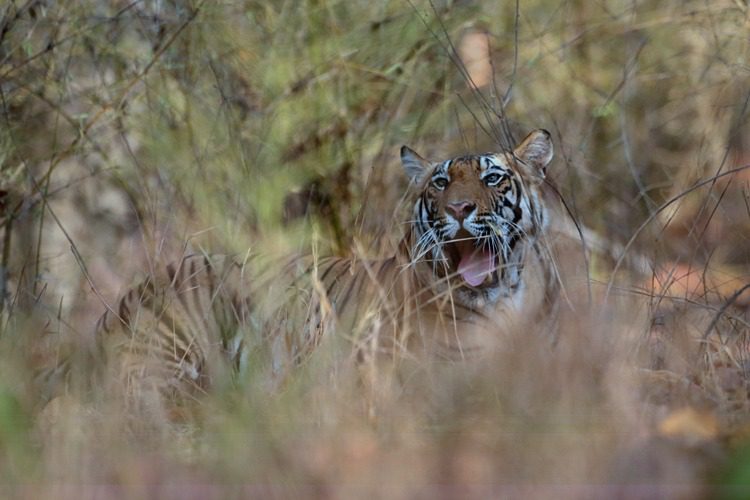Tigers of Bandhavgarh National Park
‘Bandhavgarh’ – The brother’s fort, was gifted by Lord Rama to brethren Laxmana. The significance of Bandhavgarh to hindu mythology and Indian history is intricate in its 32 hillocks, rock paintings and monuments. Surpassing such delicate and strong threads of religion, today not many visit Bandhavgarh for mythological resemblance or its enriching history. The place is famous for live, walking tigers- the original rulers of Bandhavgarh that have reclaimed the forts and grounds from the rulers of the past. Bandhavgarh National Park has the most number of tourists visiting for Tigers who do not mind if they tumble on some history on the go!
Bandhavgarh does not have the maximum numbers or the maximum density of Tigers as interpreted by many. The vegetation of Bamboo forests, vast spreading grasslands makes it comparatively easier to spot a tiger here, than in Corbett or Kaziranga- the parks with the highest density of tigers. Almost guaranteed sightings of Tiger have helped the guides and regular tourists to understand tigers of Bandhavgarh, more deeply than at any other place.
Tigers of Today
Bheema, Bamera, Chandini, Kankati, Rajbhera, Dotty Krishna, Sukhipatia, Marchaini are few of the famous striped cats of Bandhavgarh. They are recognized more by their territory than their facial and stripe marks, which is the suggested way of identifying tigers in the wild. Cubs of present day are named even before they have claimed their territory. The Tigers once almost vanished from Bandhavgarh, succumbing to poaching, habitat loss and trophy hunting practices by the kings and his invitees from princely states. It was realized in time that such fauna cannot be left at the mercy of guns and humans. Game drives were banned for one and all and Bandhavgarh was declared as a National Park in 1968. Tiger habitats are conserved, forever, in the preludes of Project tiger since 1993. The trophies of conservation which have doubled the number of tigers in the region and retained the austere history and habitat are for everyone to watch and learn from. At present there are more than 60 tigers in Bandhavgarh. Together from its three zones only 20% of the total core area is open for tourism.
Tiger Parents of Yesterday: Sita And Charger
It all started from Charger, the dominant male tiger of Bandhavgarh, named after his habit of mock charging every jeep and mahout, now and then. All these roaring tigers of Bandhavgarah are the heritors of Sita (the most popular female of Bandhavgarh) and Charger. Charger took over the male territory of ‘banka’ tiger in the Chakradhara area after what is described by the now promoted senior forest guards as the longest nights of tiger growls and fights between Banka and Charger. Kuttapan, the beloved mahout of Bandhavgarh was the first one to confirm that Banka was overthrown and Charger had overtaken his territory. Charger ruled the area from 1991-99. His mate, Sita was the most photographed tiger of the world; she was last seen in 1998. She raised six litters in total, the earlier ones from Banka and the rest from ‘Charger’. Bara Baccha- The bigger one, Langru- the limping one, Mohini (beautiful tigress), pyari (Chakradhara female) and Reshma (Banbehi Female) were all mothered by Sita.
It is studied that the tigress solely takes the responsibility of the cubs, raises them and teaches them the skills of survival and ruling the jungle. The males separate and go far away to establish fresh territories however females have smaller overlapping territories. Charger and Sita were an exception to this rule; they stayed together for years and even raised their limping cub- Langru till almost four years of age.
Sita died first, due to old age followed by Charger’s exiting from Chakradhara into Rajbahera area. His Chakradhara territory was overtaken by B1, B2 and B3. Knowing charger’s temperament and reputation the fights between the new tigers and Charger were obvious. His last fight was with B2 after which Charger faced severe injury and was transferred under the care of Forest Department. After his death in the year 2000, ‘Charger point’ was made as an epitaph on his cremation site, Magdhi Zone.
After a decade and a half, stories of Sita and Charger sell like hotcakes in Bandhavgarh, their pictures still are embraced by the lucky ones who saw them. For those who missed their sight, they have left behind the new generation Tiger families of Bandhavgarh, which have been fascinating Tiger lovers. The guides often stop at Charger point in Magadhi Zone and narrate the anecdotes from Charger’s era in Bandhavgarh.
Courtesy : Vineeta Yadav
Photo Credits : Ashish Tirkey, Naresh Singh, Lalit Rajora
Visit our lodges in Kanha, Bandhavgarh, Pench, Satpura and Panna to watch these fascinating species frolic in the wild. Get in touch with our trip curators at Pugdundee Safaris to book your next wildlife holiday.
Our trip curators at Pugdundee Safaris are more than happy to assist you. Phone: +91-011-40132680 Email: [email protected]




